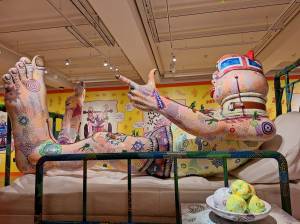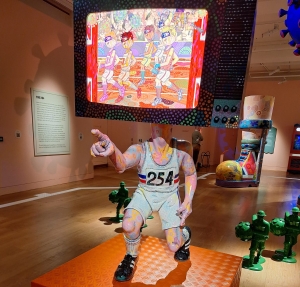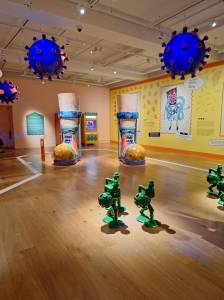Until 12th January 2025, Jason and the Adventure of 254 at the Wellcome Collection, London, transports visitors to Pinderfields Hospital in Wakefield on 1st August 1980, at 2:54 pm, where eleven-year-old Jason Wilsher-Mills lies in a hospital bed, paralysed from the neck down due to an autoimmune condition. Meanwhile, in Moscow, British athlete Sebastian Coe (b. 1956), wearing the number 254, secured victory in the 1,500-meter men’s race at the Olympics, which Wilsher-Mills watched on the hospital ward’s TV. Jason Wilsher-Mills explores his childhood recollections of his experiences during this pivotal period.
Originally from Wakefield, West Yorkshire, UK, Jason Wilsher-Mills is an artist who examines narratives of disability, health, and identity, employing playful humour and vibrant magic realism. He seeks to create new storytelling methods that align with the social model of disability, emphasising that society disables individuals by not accommodating everyone’s needs.
The exhibition’s main focus is a figure watching television from a hospital bed. The TV has transformed into Sebastian Coe, identified by his racing number 254, which happens to be the exact moment (2:45 pm) he won the race and when Jason’s parents received their devastating news. The body reflects Jason’s feelings, with his feet swollen to represent extreme pain and fairground lights depicting awry neurological signals. Toy soldiers surrounding Jason and Sebastian are wielding viruses, symbolising the metaphor used by the doctor to explain Jason’s autoimmune condition as an army of white blood cells attacking instead of defending.
Calliper boots, a motif often seen in Wilsher-Mills’ work, were a significant part of his childhood. Originally designed to support his weight and train his ankles, he found them cumbersome. He has since reimagined them as a symbol of pride and identity, resembling Dr Martens and featuring the Union Jack flag and other patterns to represent Britain and his inner feelings.
The exhibition is like a time capsule of the popular culture that influenced Wilsher-Mills during childhood. He took inspiration from TV shows like Batman and Doctor Who and his favourite comic, The Beano. Using these influences, he has created various alter egos, such as Frankenfoot and MRI-boy, whose images cover the walls along with a timeline of events. Key dates include contracting chicken pox in April 1980, being told by a doctor he was merely suffering growing pains in June 1980, and being diagnosed with polyneuropathy in August 1980.
The installation features dioramas that represent moments from the artist’s past. These miniature scenes are housed in machines that light up at the press of a button. They symbolise the artist’s journey from childhood to becoming an artist and offer a glimpse into his experiences. Family is a central theme in these dioramas. One of the artworks, Mum as a Mermaid, shows Wilsher-Mills’ mother as a mermaid dancing with a North Sea cod. Other scenes depict comedic moments from Wilsher-Mills’ teenage years spent in a paralysed state. The Pee and the Fruit recounts the story of Jason’s brother-in-law eating an apple from his bedside, not realising it had been covered in urine, much to Jason’s later amusement. Uncle Dennis and the Inseminouds represents his uncle’s visits to the hospital, where he would share details of the VHS films he had been watching, regardless of whether they were suitable for Jason’s age. The alien figure in the artwork symbolises Jason’s body fighting against his illness.
Other works by Wilsher-Mills explore the idea of living parallel lives. In Trinity, he references his talent as a rugby league player as a child and the physical ability he lost. In Painting With My Mouth, he acknowledges the importance of his hospital education, which led him to become an artist. In this piece, Jason depicts himself as a Dalek from Doctor Who painting on an easel, surrounded by small versions of his other artworks.
“It was at [the hospital] school that I was taught to paint with my mouth. This was such a huge, momentous thing, as my energies now went into creating new worlds. I wasn’t limited to just living in my head; I could externalise my imagination in a very real way. I filled up many sketchbooks and started to create characters. It was the start of my journey as an artist.” – Jason Wilsher-Mills
Chronic polyneuropathy and chronic fatigue syndrome left Wilsher-Mills paralysed from the neck down for five years. Additionally, he has suffered tendon damage, making drawing difficult. He sees his art as similar to the Beano comic strip. His exhibitions are usually funny and political, focusing on positivity rather than anger. He often incorporates interactive elements and inflatable sculptures into his work. More recently, he has used an iPad as a tool, inspired by painter David Hockney (b. 1937).
At the age of twelve, Wilsher-Mills was refused entry to a cinema due to being deemed a “fire hazard” because of his wheelchair. This experience fueled his desire to fight against discrimination. In 2015, he created two banners for the Houses of Parliament, one commemorating the Disability Discrimination Act.
“An emotional and whimsical expression of the joys of being human, fun for the whole family, and has something powerful to say about how society perceives disability.” – Metro
Inspired by 1980s TV and anatomical drawings, the colourful exhibition Jason and the Adventure of 254 celebrates family and creativity with a hint of magical realism and humour. The installation encourages visitors to interact with the push-button lights and touch the artwork gently. The exhibition will be at the Wellcome Collection until January 2025 and is free to visit.
If you would like to support my blog, become a Patreon from £5p/m or “buy me a coffee” for £3. Thank You!







This somewhat unusual exhibition has been excellently researched by Hazel who brings Jason’s artworks of imagination to life as well as relating his story sympathetically. Well done Hazel for introducing me to another, up until now, unknown talent.
What an extraordinary exhibition. Thank you Hazel for explaining the artist’s concept and motivation. Obviously it would be better for people to see it for themselves but this is the next best thing for those of us unable to get to the Wellcome Collection.